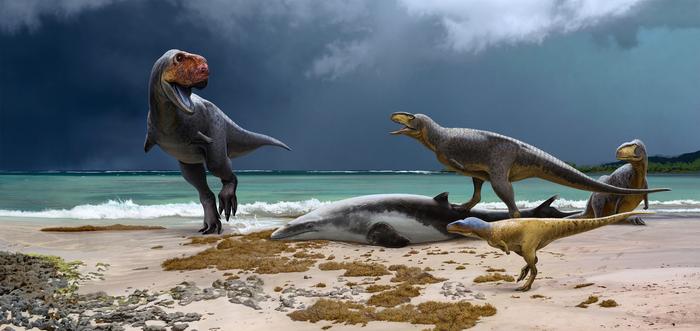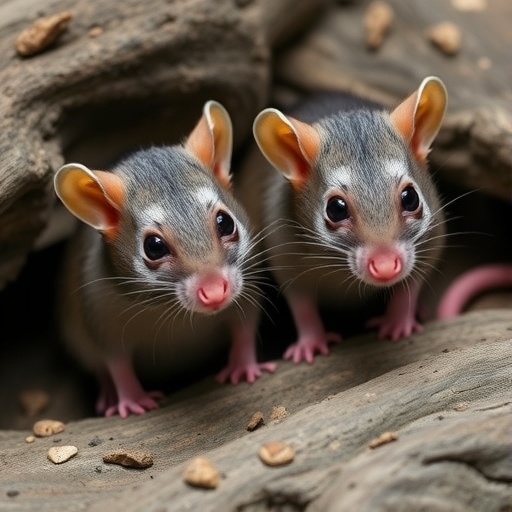Fossils of primitive cousins of T. rex that had short, bulldog snouts and even shorter arms have been discovered by scientists in Morocco. The two new dinosaur species belong to the Abelisauridae, a family of carnivorous dinosaurs that were counterparts to the tyrannosaurs of the Northern Hemisphere. They lived at the end of the Cretaceous period and show that dinosaurs were diverse in Africa just before their mass extinction by an asteroid 66 million years ago.

Credit: Andrey Atuchin
Fossils of primitive cousins of T. rex that had short, bulldog snouts and even shorter arms have been discovered by scientists in Morocco. The two new dinosaur species belong to the Abelisauridae, a family of carnivorous dinosaurs that were counterparts to the tyrannosaurs of the Northern Hemisphere. They lived at the end of the Cretaceous period and show that dinosaurs were diverse in Africa just before their mass extinction by an asteroid 66 million years ago.
Two new species of dinosaur have been found from the end of the Cretaceous in Morocco, just outside of Casablanca. One species, found near the town of Sidi Daoui, is represented by a foot bone from a predator about two and a half metres (eight feet) long. The other, from nearby Sidi Chennane, is the shin bone of a carnivore that grew to around five metres (15 feet) in length.
Both were part of a family of primitive carnivorous dinosaurs known as abelisaurs, and lived alongside the much larger abelisaur Chenanisaurus barbaricus, showing that Morocco was home to diverse dinosaur species just before a giant asteroid struck at the end of the Cretaceous, ending the age of dinosaurs.
Dr Nick Longrich, from the Milner Centre for Evolution at the University of Bath, led the study. He said: “What’s surprising here is that these are marine beds.
“It’s a shallow, tropical sea full of plesiosaurs, mosasaurs, and sharks. It’s not exactly a place you’d expect to find a lot of dinosaurs. But we’re finding them.”
Even though dinosaurs account for a small proportion of the fossils, the region is so rich in fossils, it has produced the best picture of African dinosaurs from the end of the age of dinosaurs.
Rather than finding the same few species, palaeontologists often recover fossils from new species, suggesting the beds host an extremely diverse dinosaur fauna.
So far, the small number of dinosaur fossils that have been recovered represent five different species – a small duckbill dinosaur named Ajnabia, a long-necked titanosaur, the giant abelisaur Chenanisaurus, and now the two new abelisaurs.
Dr Longrich said: “We have other fossils as well, but they’re currently under study. So we can’t say much about them at the moment, except that this was an amazingly diverse dinosaur fauna.”
The last dinosaurs vanished around 66 million years ago, along with as much as 90% of all species on earth, including mosasaurs, plesiosaurs, pterosaurs and ammonites. The pattern of the end-Cretaceous extinction and its causes have been debated for over two hundred years.
A giant asteroid impact in the Yucatan peninsula has been linked to their demise, although it’s been argued that dinosaurs were already in decline. The Moroccan dinosaurs suggest that they thrived in North Africa up to the very end.
“The end of the Cretaceous in western North America definitely seems to become less diverse at the end,” said Longrich. “But that’s just one small part of the world. It’s not clear that you can generalise from the dinosaurs of Wyoming and Montana to the whole world.
“It also grew colder near the end, so it might not be surprising if dinosaurs at higher latitudes became less diverse. But we don’t know much about dinosaurs from lower latitudes.”
In Morocco at least, they seem to have remained diverse and successful up until the end.
“When T. rex reigned as a megapredator in North America, abelisaurs sat at the top of the food chains in North Africa,” said Nour-Eddine Jalil, a professor at the Natural History Museum and a researcher at Universite Cadi Ayyad in Morocco, who was a co-author on the paper.
“The dinosaur remains, despite their rarity, give the same messages as the more abundant marine reptile remains.
“They tell us that, just before the Cretaceous-Paleogene crisis, biodiversity was not declining but on the contrary, was diverse.”
The new study is published in Cretaceous Research by Dr Nick Longrich from the University of Bath, Prof. Xabier Pereda-Suberbiola and Erik Isasmendi of the Basque Country in Bilbao, and Nour-Eddine Jalil of the Museum of Natural History of Paris and Universite Cadi Ayyad in Marrakech.
Journal
Cretaceous Research
DOI
10.1016/j.cretres.2023.105677
Subject of Research
Not applicable
Article Title
New fossils of Abelisauridae (Dinosauria: Theropoda) from the upper Maastrichtian of Morocco, North Africa
Article Publication Date
22-Aug-2023





